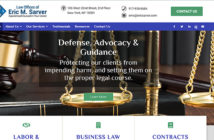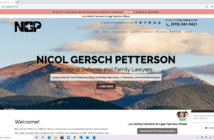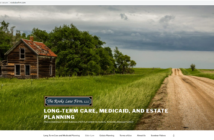“Most of my clients come from referrals from other attorneys, from former clients, and from doctors and mental health professionals.”
If you run a small law firm that competes against bigger firms with large ad budgets, finding affordable ways to promote your law firm can be challenging. When the bigger competitors are national firms who can produce huge TV ad campaigns, you need get creative and focused.
Laura Amick Gadness, from Amick, Stevens & Gadness, learned that the key to being competitive is concentrating on what she can provide that larger firms cannot: a personal touch that doesn’t leave clients feeling like they’re cogs in a wheel.

Background
Amick, Stevens & Gadness is a law firm located in Plano, Texas. Gadness specializes in Social Security disability. She graduated from Texas Wesleyan University School of Law in 2006. She speaks frequently for CLE classes and even founded a legal referral clinic that works with a local homeless shelter.
“I’m in a lot of different groups,” Gadness said. “I’m on the board of non-profit organizations and meet a lot of people in the community through my activities.”
Although she has a website and several online profiles, she’s found that her activities in the community make the most difference when it comes to generating new clients.
The Challenges
Gadness has a small practice, so the challenge she discovered was competing with larger firms that can spend huge amounts on splashy television ads. Since her focus is Social Security disability, she can potentially be competing with even the large firms that have nationwide offices.
“A lot of large, nationwide firms probably spend an enormous amount of money advertising on TV,” she said. “I see their commercials all the time. It’s very hard to compete with that amount of TV advertising.”
Knowing she couldn’t even begin to compete by making her own ads, she decided to try a different approach.
“Smaller practitioners can’t compete on that kind of level, as far as in-your-face ads,” she said. “I try to be personable. I’m the one who’s going to actually talk to the people who call.”
In fact, the firm’s website highlights this personal touch on almost every page. On the Firm Overview page, for example, one of the top headlines reads: “Personal Attention from a Firm That Cares.”

Referrals
“Most of my clients come from referrals from other attorneys, from former clients and from doctors and mental health professionals,” Gadness said.
But being the attorney that people think of first didn’t happen overnight. She had to develop relationships with local professionals and create a strong reputation, both online and off.
Open to a Variety of Cases
One of her first steps was building a reputation for being the kind of attorney who is open to a wide variety of Social Security disability cases. This helped make people more comfortable about referring potential clients her way.
“I’m more open to cases that don’t fit into a set criteria,” she said. “One attorney I know won’t take anyone who’s working. Even though someone who’s working part time could still have a disability claim, this attorney just says no if someone’s working at all. As for me, I try to talk to as many people as I can to see if there’s any possibility that I can help them. Just because someone’s working don’t mean I’ll say no. That person might be working for a family member who’s keeping them employed just to help them out. I try to get all the information and talk to as many people as I can to see if there’s any possibility I can help.”
Gadness also tries to go the extra mile even when she decides she can’t take someone on as a client.
“Disability coverage doesn’t last forever and you have to file a claim within a certain amount of time. Sometimes a person’s case is denied because of their insurance status. But when they call an attorney’s office, the attorney might just say, ‘I can’t help you.’ They have no idea why not.”
If Gadness can’t take on someone’s case or if a case isn’t viable because of a missed deadline, for example, she always takes the time to explain why. Her helpfulness, even in situations like those, has led to her getting referrals.
“Even if I can’t help them, they appreciate (the extra information,)” she said. “Sometimes they will refer other people to me, even though I couldn’t help them.”
Teaching CLE Classes
Gadness has built her referral network by taking part in CLE classes. Her LinkedIn page prominently displays her seminar speaking experience with NBI, one of the top nationwide CLE providers.

NBI hosts nationwide teleconferences that offer CLE classes in many areas of law. One of the pluses of Social Security disability law, Gadness said, is that the governing law is federal. Because of this, classes on Social Security are applicable to attorneys across the country.

NBI gives Gadness a list of topics in the area of Social Security disability and she picks which ones she’s most interested in. Then she writes out a presentation. Her classes have helped net her quite a few referrals, especially from attorneys who watch the class and realize they don’t want to invest the time it would take to become experts on the topic themselves.
“I had an attorney once who was helping a client with another matter, and the client brought up a Social Security disability claim,” she said. “He took my CLE class to see if he could help, listened to my speech, and decided that he didn’t want to do that. So he gave his client my name instead.”
Personal Touch with Professionals
Gadness works hard to make a good impression on any medical professionals that she comes in contact with while working on a Social Security disability case. Many times, her professional attitude and willingness to go above and beyond leave a lasting impression. When the doctors or mental health professionals have patients with Social Security disability questions later on, they refer them to Gadness.
“I have my clients sign releases allowing me to share information with their doctors,” she said. “I explain to them why we’re asking for specific information. When the doctors provide information, I’ll send a letter saying thank you and how much I appreciate their time. Then I get the client’s permission to send a follow-up letter. I don’t just fill out a form, but I give the doctors information about what happened in the case.”
Doctors appreciate that she takes time out of her schedule to send them thoughtful letters.
“I’ve had doctors give my name out to other patients they had,” she said. A lot of doctors are taking extra time to fill out disability forms. They probably don’t get thanked for it a lot.”
Local Bar Associations
Gadness also makes contacts by staying active in her local bar associations and attending legal conferences.
“I’ve given speeches at local bar associations,” she said. “I gave a presentation at a conference in February that was for lawyers from Texas, Louisiana and Mississippi. And I’m speaking this week at a local attorneys group. It’s a good way to get your name out there.”
She said that with local associations, she may have to approach them first and suggest a topic. They’re usually eager to have a speaker at their meetings.
Additional Marketing Techniques
Initial Contact Forms
Gadness gets quite a few clients through the contact form on her law firm’s website.

She said that one of the keys is being open to talking to potential clients in any way that’s convenient for them. She’ll e-mail them, call them on the phone, or set up a meeting in person. Because some Social Security disability clients have a tough time getting around, it’s important to be flexible in how a meeting or consultation is conducted.
Gadness also carries business cards and pamphlets with her and distributes them according to how much information she thinks the person will want.
“Sometimes you can gauge when networking with someone if they want more information or not,” she said. “I try to have the pamphlet as an option for someone who wants a little more information. And then there are people who aren’t web savvy and they need something more than just a card.”
Her pamphlet, which has a basic tri-fold design, has much of the same information as what’s on her firm’s website:
- The basics about disability and SSI Programs
- How to file for a disability application
- Basic information about claims hearings
- The important of getting medical evidence
- The 60-day deadline to appeal if a claim is denied
- The Social Security Administration’s 800 number
- Attorney’s fees – clients don’t pay unless they win
- Information about Gadness and her background
- Contact information
“I try to tell them (in the pamphlet) that I provide personal attention and want to answer all their questions along the way,” she said.
Advertising for the Smaller Budget
Gadness is very selective in how she spends her limited advertising money. She doesn’t buy ads on Google or television ads.
“I also don’t buy advertising in the phone book or in direct mail pieces,” she said. “I don’t think people look at that much anymore.”
She has, however, purchased ads when her local bar association had a monthly print publication.
“A lot of people don’t know any attorneys who do what I do,” she said. “I put in this ad so local attorneys would know there’s someone in this town who does Social Security disability work. You can’t know every lawyer in your town, so this helped. It only cost $20 a month.”
Updating Online Profiles
Another tactic that Gadness uses is making sure her online profiles are up-to-date. Because so many services add automatic profiles of attorneys found in bar records, she searches for new profiles every now and then to make sure she hasn’t missed anything.
“I try to Google myself from time to time to see what’s out there.”
She has updated profiles on sites like Avvo, Google, LinkedIn and Yelp.
“Some of these have everybody listed,” she said. “You can go in and add pictures and profile information. Our web designer talked to us about all the different listings that we should be on. I’ve had a few people mention lately seeing me on there.”

By keeping her profile updated, clients also feel more comfortable leaving reviews. Gadness has positive reviews on Yahoo, Google and Avvo.
“It’s really nice that my clients do that,” she said. “People have gone on the Internet and seen good things about me. I’ve had a few people mention lately, ‘I read a review that was really good about you.’”
Volunteering
Gadness also spends a lot of time volunteering her services to help people who are less fortunate. She doesn’t do this for the specific purpose of finding new clients, but she said it can be a good way to get your name out there.
“I founded a legal assistance and referral clinic,” she said. “Any time you’re volunteering and meeting people, you’re getting your name out there that could potentially get results. I wouldn’t be doing this just to build a referral base, but if it’s something you’re passionate about, it couldn’t hurt.”
She says that all attorneys should volunteer some of their time with Legal Aid. “They always need private attorneys to take cases,” she said. “They always have more cases than they can handle.”
How to Get Started
Getting started building referrals isn’t complicated. By treating your clients professionally and going the extra mile, you’re likely get referrals that way alone.
Send Notes
In this day and age, e-mails and text messages are the most common form of communication. But if you send a note to the professionals you work with, they’ll be more likely to remember you. For example, you can stand out from other attorneys by writing thank-you notes to the professionals who help you. If you’re filing a Social Security claim and need information from a doctor, send him a note later thanking him for his time. Many attorneys don’t take these simple steps, and it could make a big difference in the long run.
Get your client’s permission to explain to his doctor why you’re asking for information and what the result is after the case is over. This can help the doctor understand why certain information is needed. It will also result in the doctor being more likely to recommend your services to future patients.
Connecting with Local Bar Associations
Offering to give a speech about your specialty to local bar groups is a great way to start making connections.
“Any local bar association is pretty desperate to have speakers on anything,” Gadness said. “This is always a good way to get to know some other people.”
The key is to come up with an idea that the association will find intriguing. If you want to speak to a group that focuses on a specialty in law, look for unique ways that your practice overlaps.
“At my local Social Security attorneys group, we had a criminal law attorney approach us about networking,” Gadness said. “He wrote a presentation for us about how we can get our clients’ medical records from jail and how to get drug test results from probation officers. If you practice in Social Security disability law, look for areas that can overlap there. Like with family law, if someone’s getting divorced and they have a disabled child, they’d need information on Social Security disability.”
Speaking to divorce attorneys about Social Security law is a good topic idea, she said. “I’ve testified in divorce cases about someone’s benefits because in a trial, the attorneys and the judge may not really know how the benefits are impacted by divorce. In Texas, disability of one of the spouses can affect the possibility of post-marital support.”
After you suggest the topic, you’ll likely need to write your presentation first and show it to the person in charge of coordinating the local association’s meetings. Once your presentation is approved, you’ll be on the schedule and ready to share your knowledge with others. It can be helpful to keep copies of your presentation notes available online in a password-protected page on your website. On the back of your business card, write the link to where attendees can get the notes and the password they’ll need to use. This will encourage people who heard your talk to visit your website later.
Teaching CLE Classes
Review your specialization and brainstorm any areas that would make good CLE topics. Contact NBI and similar national organizations that offer CLE classes to find out what steps you need to take to become a CLE teacher.
“NBI and places like that will guide you on what topics they want spoken about,” Gadness said. She’s usually given a list of possibilities. She then writes up a presentation based on one of the topics, which her NBI contact reviews, and they proceed from there.
When other attorneys see her teaching a CLE class, they see her as an expert on the topic. If they have questions, they’re more likely to contact her or even refer clients to her.
Make Sure Your Online Profiles are Complete
This part is key if you’re relying on networking. Your connections need a way to reach you and a place to send your clients. Of course, you’ll have business cards and your phone line will always be open. But people need a place they can go online to learn more about you, to contact you in a less-intimidating way, and to see what other people think about you.
Like Gadness suggested, Google your own name to see what services have already created placeholder profiles for you. These will likely be on places such as Avvo, Yelp and Google, which show up at the top of search results. Complete profiles for yourself on these sites, including a professional photo and a bio. Then ask a few satisfied clients to leave positive reviews. This way, if someone searches your name online after getting a referral, they’ll find positive, detailed information about you right away.
Conclusion
Don’t let your firm’s small size intimidate you, even if you’re competing in a field that has a national focus like Social Security disability. You don’t have to market your services in the same way that the big national firms do. You don’t need a TV ad running right after theirs in order to get clients. Old-fashioned networking, coupled with an easily accessible online profile, can bring in a sizeable amount of clients.




